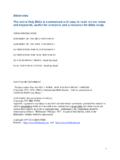Transcription of CHRISTIAN LEADERSHIP Teacher’s Manual
1 CHRISTIAN LEADERSHIPT eacher s ManualbyRoger L. Smalling, Church In AmericaThe textbook for this course is available for KINDLE Copyright 2004, Miami, FLAbout the authorDr. Roger Smalling has been in ministry since 1964, when he went as a missionary to Europe with an independent mission organization. His LEADERSHIP experience has included Field Leader for France, then later in South America as Team and Field Leader for Ecuador, as well as Assistant Regional Director for Latin America with that , while serving with the Presbyterian Church in America in Ecuador, he was instrumental in creating a successful LEADERSHIP training system for the national Presbytery.
2 This Manual is part of that Smalling is founder and director of Visi n , an acronym in Spanish for Reformation In Latin America. This involves establishing and supervising LEADERSHIP training centers along with writing and distributing their literature. The Smallings also travel throughout the region as conference and seminar author s philosophy of leadershipThe bible teaches one style of CHRISTIAN LEADERSHIP . Christ himself modeled and summarized it in Matthew 20. Principles of service and suffering form the basis of the leader s relationship with his subordinates.
3 The leader also portrays equality and mutual respect toward his ministerial colleagues. This author is Presbyterian in his theology of church government. He is anti-hierarchical regarding relationships between ministers. Scripture and experience reveal that CHRISTIAN hierarchies among ministers often generate abuses resulting in the nullification of the spiritual authority of those ordained to the holy offices. CHRISTIAN LEADERSHIP philosophy in the modern world is profoundly affected by corporate business management ideas.
4 Many CHRISTIAN LEADERSHIP books are merely warmed-over American business culture expressed in religious language. Christians successful in business LEADERSHIP in a secular setting may imagine that by writing books, they can take their success and bring it into the church and thus make God s Kingdom though efficiency were a high value in the Kingdom of this may indeed augment the efficiency of the church, but at the price of the same abuses that exist in the business world. With their hierarchical mind-set, these writers fail to see the forest because of the Nevertheless, some modern managerial techniques are helpful.
5 The author has included a few where they build relationships without being manipulative. People, not products, are the focus of God s OF CONTENTS Syllabus LESSON 1: The CHRISTIAN Philosophy of LeadershipLESSON 2: The Dangers of HierarchiesLESSON 3: Principle Activities of the CHRISTIAN LeaderLESSON 4: Vision and PlanningLESSON 5: Goal SettingLESSON 6: Communication with SubordinatesLESSON 7: Medium-Level Moral Issues LESSON 8: Serious Moral ProblemsLESSON 9: Problematic PeopleLESSON 10: Dealing with WolvesLESSON 11: Conflict ResolutionLESSON 12: Creative ThinkingLESSON 13: Decision Making LESSON 14.
6 Verbal Self DefenseLESSON 15: Ministerial EthicsLESSON 16: Relationships Between LeadersSyllabus This course was written originally in Spanish for the preparation of LEADERSHIP candidates in the Quito, Ecuador Presbytery of the Presbyterian Reformed Churches of Ecuador. The idea is a self-reproducing system in which the teacher uses a Manual he reproduces as he teaches and gives to his students. At the end of the course, the student not only knows the material, but has the tool necessary to teach it to others.
7 The course is therefore not auto-didactic. Nor is it principally academic in nature. A mature teacher must be prepared to play the role of mentor to his students, rather than a mere communicator of number of students in the class should be small, to allow for the interchange necessary in the mentoring process. Eight to twelve students is ideal. Purpose Establish in the mind of the student the biblical concept of servant LEADERSHIP , by comparing it with the authoritarian hierarchies generally practiced in worldly contexts such as business, government and some religious institutions.
8 Create in the student a strong sense of integrity with regard to LEADERSHIP , help him identify unbiblical motives for desiring offices in the church, and replace those motives with the right ones. Identify and practice non-manipulative techniques for assisting his subordinates to grow in The required textbook for the course is Smalling's CHRISTIAN LEADERSHIP , available free on Smalling's website, or through Kindle for a small fee. The course also recommends Oswald Sanders book SPIRITUAL LEADERSHIP . The teacher may require this text or not, according to his discretion.
9 Sanders book is excellent for the character-development aspect of the training, which is central to the course. It deals adequately with correct motivations as well as the biblical requirements for the spiritual life of a , Sanders book lacks specific and practical managerial information the student needs to begin practicing LEADERSHIP . Therefore, the teacher should not focus on the content of the book during class sessions. Sanders is homework reading only. The majority of classroom time should be used for discussion of concrete applications of LEADERSHIP techniques.
10 It may be a temptation for the teacher to depend too much on Sanders. He should avoid this. The teacher must also be aware this course overlaps with two others: Ecclesiology, and Personal Revival. The nature of the material touches unavoidably on aspects of church government, especially when we get to issues such as discipline in the church or parity of elders. Likewise, when the course touches on decision-making, some of the material in Personal Revival becomes relevant, such as the part on divine guidance.
